Analysis of the International Labour Organisation and Child Labour
VerifiedAdded on 2023/05/28
|13
|4076
|134
Report
AI Summary
This report provides a detailed analysis of the International Labour Organisation (ILO), commencing with its establishment and objectives. It delves into the ILO's structure, encompassing the International Labour Conference, Governing Body, and International Labour Office, and their respective functions. The report then focuses on the issue of child labour, examining the ILO's initiatives, including the International Programme on the Elimination of Child Labour (IPEC), and relevant conventions such as the Minimum Age Convention No. 138. Furthermore, it explores the impact of the ILO's objectives and concludes with a discussion of the landmark case of M.C. Mehta vs. State Of Tamil Nadu And Ors, highlighting the Supreme Court's consideration of international labour law provisions in conjunction with domestic laws. The report underscores the ILO's crucial role in setting labour standards, promoting decent work conditions, and combating child labour on a global scale.
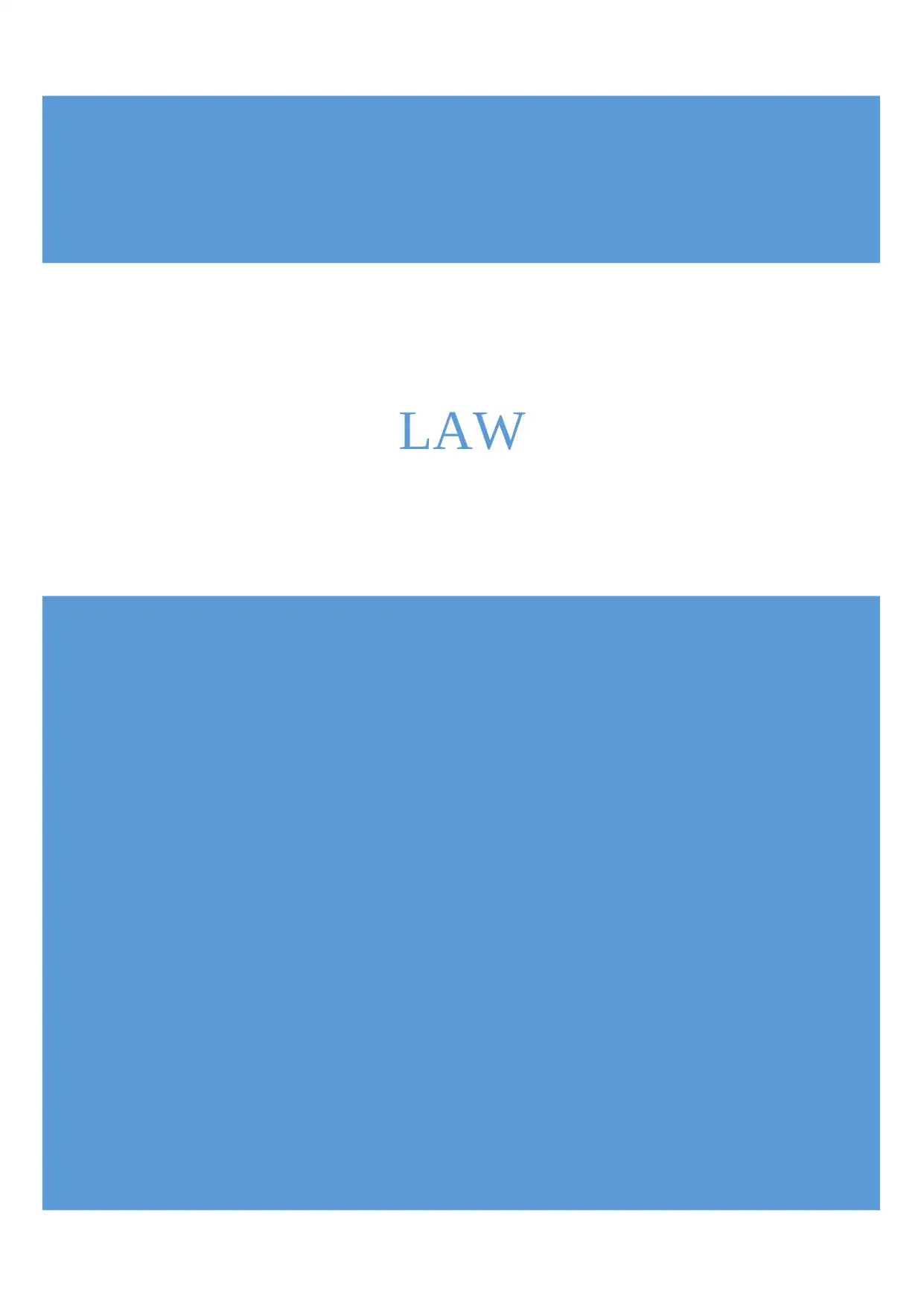
LAW
Paraphrase This Document
Need a fresh take? Get an instant paraphrase of this document with our AI Paraphraser
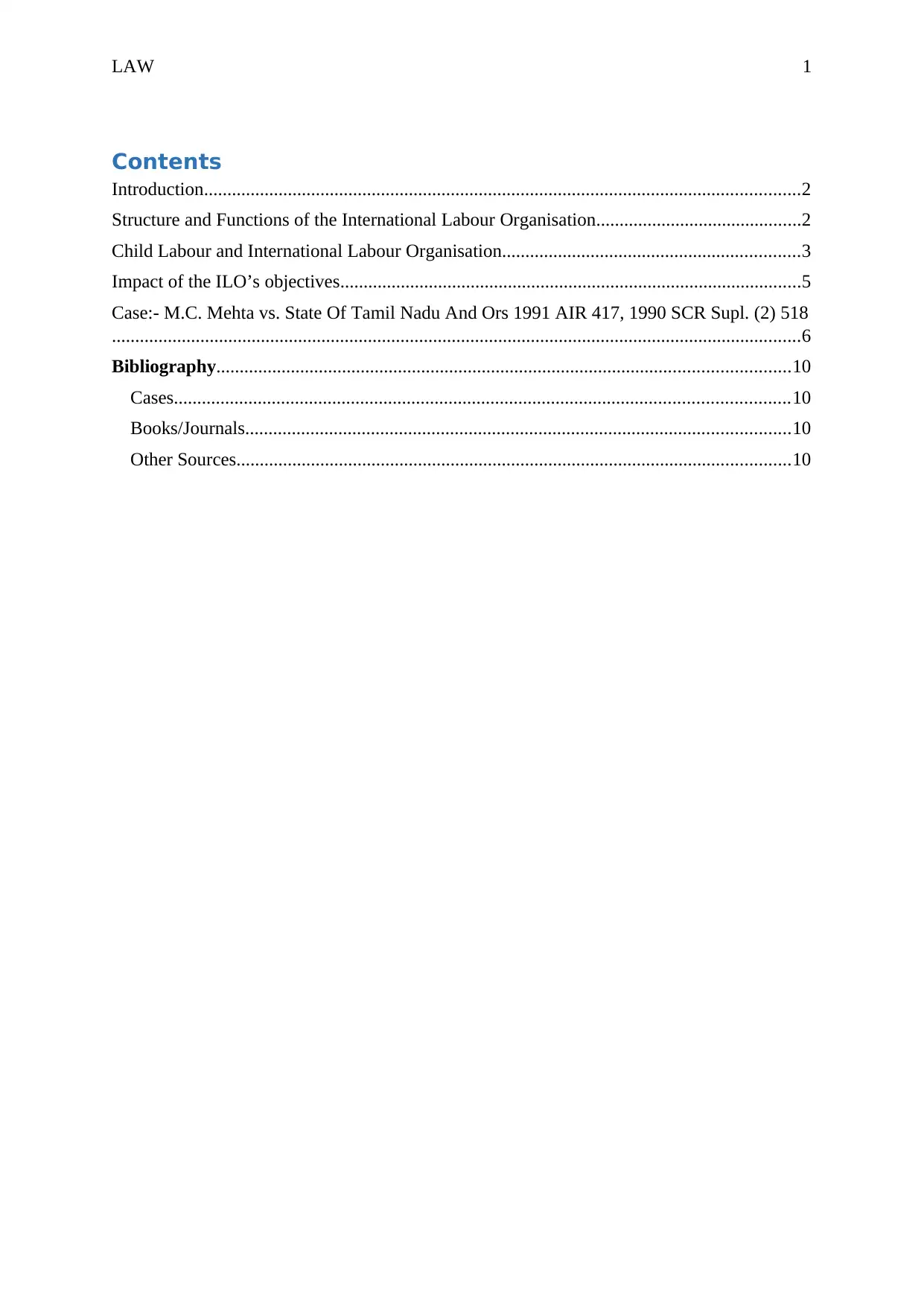
LAW 1
Contents
Introduction................................................................................................................................2
Structure and Functions of the International Labour Organisation............................................2
Child Labour and International Labour Organisation................................................................3
Impact of the ILO’s objectives...................................................................................................5
Case:- M.C. Mehta vs. State Of Tamil Nadu And Ors 1991 AIR 417, 1990 SCR Supl. (2) 518
....................................................................................................................................................6
Bibliography...........................................................................................................................10
Cases....................................................................................................................................10
Books/Journals.....................................................................................................................10
Other Sources.......................................................................................................................10
Contents
Introduction................................................................................................................................2
Structure and Functions of the International Labour Organisation............................................2
Child Labour and International Labour Organisation................................................................3
Impact of the ILO’s objectives...................................................................................................5
Case:- M.C. Mehta vs. State Of Tamil Nadu And Ors 1991 AIR 417, 1990 SCR Supl. (2) 518
....................................................................................................................................................6
Bibliography...........................................................................................................................10
Cases....................................................................................................................................10
Books/Journals.....................................................................................................................10
Other Sources.......................................................................................................................10
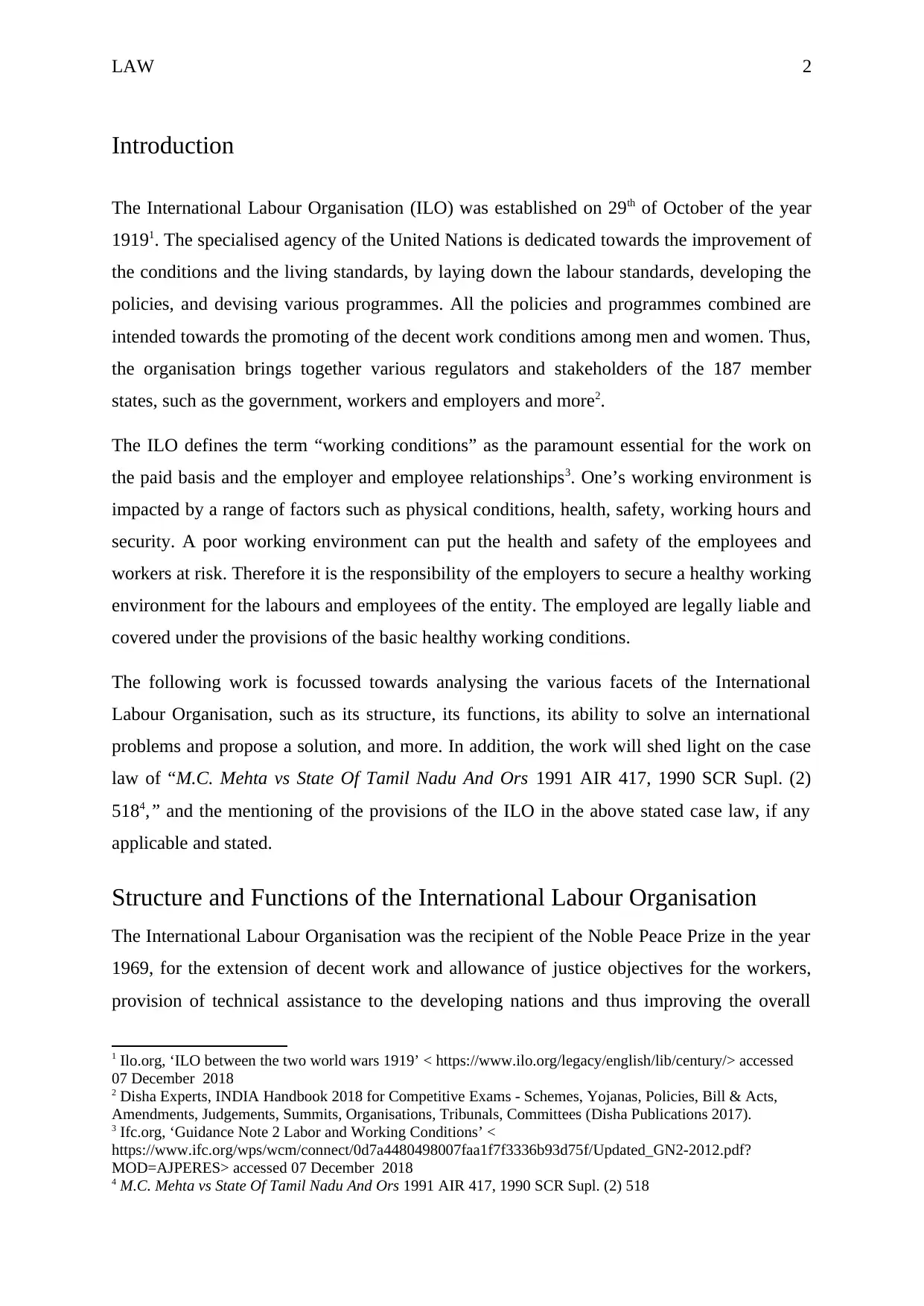
LAW 2
Introduction
The International Labour Organisation (ILO) was established on 29th of October of the year
19191. The specialised agency of the United Nations is dedicated towards the improvement of
the conditions and the living standards, by laying down the labour standards, developing the
policies, and devising various programmes. All the policies and programmes combined are
intended towards the promoting of the decent work conditions among men and women. Thus,
the organisation brings together various regulators and stakeholders of the 187 member
states, such as the government, workers and employers and more2.
The ILO defines the term “working conditions” as the paramount essential for the work on
the paid basis and the employer and employee relationships3. One’s working environment is
impacted by a range of factors such as physical conditions, health, safety, working hours and
security. A poor working environment can put the health and safety of the employees and
workers at risk. Therefore it is the responsibility of the employers to secure a healthy working
environment for the labours and employees of the entity. The employed are legally liable and
covered under the provisions of the basic healthy working conditions.
The following work is focussed towards analysing the various facets of the International
Labour Organisation, such as its structure, its functions, its ability to solve an international
problems and propose a solution, and more. In addition, the work will shed light on the case
law of “M.C. Mehta vs State Of Tamil Nadu And Ors 1991 AIR 417, 1990 SCR Supl. (2)
5184,” and the mentioning of the provisions of the ILO in the above stated case law, if any
applicable and stated.
Structure and Functions of the International Labour Organisation
The International Labour Organisation was the recipient of the Noble Peace Prize in the year
1969, for the extension of decent work and allowance of justice objectives for the workers,
provision of technical assistance to the developing nations and thus improving the overall
1 Ilo.org, ‘ILO between the two world wars 1919’ < https://www.ilo.org/legacy/english/lib/century/> accessed
07 December 2018
2 Disha Experts, INDIA Handbook 2018 for Competitive Exams - Schemes, Yojanas, Policies, Bill & Acts,
Amendments, Judgements, Summits, Organisations, Tribunals, Committees (Disha Publications 2017).
3 Ifc.org, ‘Guidance Note 2 Labor and Working Conditions’ <
https://www.ifc.org/wps/wcm/connect/0d7a4480498007faa1f7f3336b93d75f/Updated_GN2-2012.pdf?
MOD=AJPERES> accessed 07 December 2018
4 M.C. Mehta vs State Of Tamil Nadu And Ors 1991 AIR 417, 1990 SCR Supl. (2) 518
Introduction
The International Labour Organisation (ILO) was established on 29th of October of the year
19191. The specialised agency of the United Nations is dedicated towards the improvement of
the conditions and the living standards, by laying down the labour standards, developing the
policies, and devising various programmes. All the policies and programmes combined are
intended towards the promoting of the decent work conditions among men and women. Thus,
the organisation brings together various regulators and stakeholders of the 187 member
states, such as the government, workers and employers and more2.
The ILO defines the term “working conditions” as the paramount essential for the work on
the paid basis and the employer and employee relationships3. One’s working environment is
impacted by a range of factors such as physical conditions, health, safety, working hours and
security. A poor working environment can put the health and safety of the employees and
workers at risk. Therefore it is the responsibility of the employers to secure a healthy working
environment for the labours and employees of the entity. The employed are legally liable and
covered under the provisions of the basic healthy working conditions.
The following work is focussed towards analysing the various facets of the International
Labour Organisation, such as its structure, its functions, its ability to solve an international
problems and propose a solution, and more. In addition, the work will shed light on the case
law of “M.C. Mehta vs State Of Tamil Nadu And Ors 1991 AIR 417, 1990 SCR Supl. (2)
5184,” and the mentioning of the provisions of the ILO in the above stated case law, if any
applicable and stated.
Structure and Functions of the International Labour Organisation
The International Labour Organisation was the recipient of the Noble Peace Prize in the year
1969, for the extension of decent work and allowance of justice objectives for the workers,
provision of technical assistance to the developing nations and thus improving the overall
1 Ilo.org, ‘ILO between the two world wars 1919’ < https://www.ilo.org/legacy/english/lib/century/> accessed
07 December 2018
2 Disha Experts, INDIA Handbook 2018 for Competitive Exams - Schemes, Yojanas, Policies, Bill & Acts,
Amendments, Judgements, Summits, Organisations, Tribunals, Committees (Disha Publications 2017).
3 Ifc.org, ‘Guidance Note 2 Labor and Working Conditions’ <
https://www.ifc.org/wps/wcm/connect/0d7a4480498007faa1f7f3336b93d75f/Updated_GN2-2012.pdf?
MOD=AJPERES> accessed 07 December 2018
4 M.C. Mehta vs State Of Tamil Nadu And Ors 1991 AIR 417, 1990 SCR Supl. (2) 518
⊘ This is a preview!⊘
Do you want full access?
Subscribe today to unlock all pages.

Trusted by 1+ million students worldwide
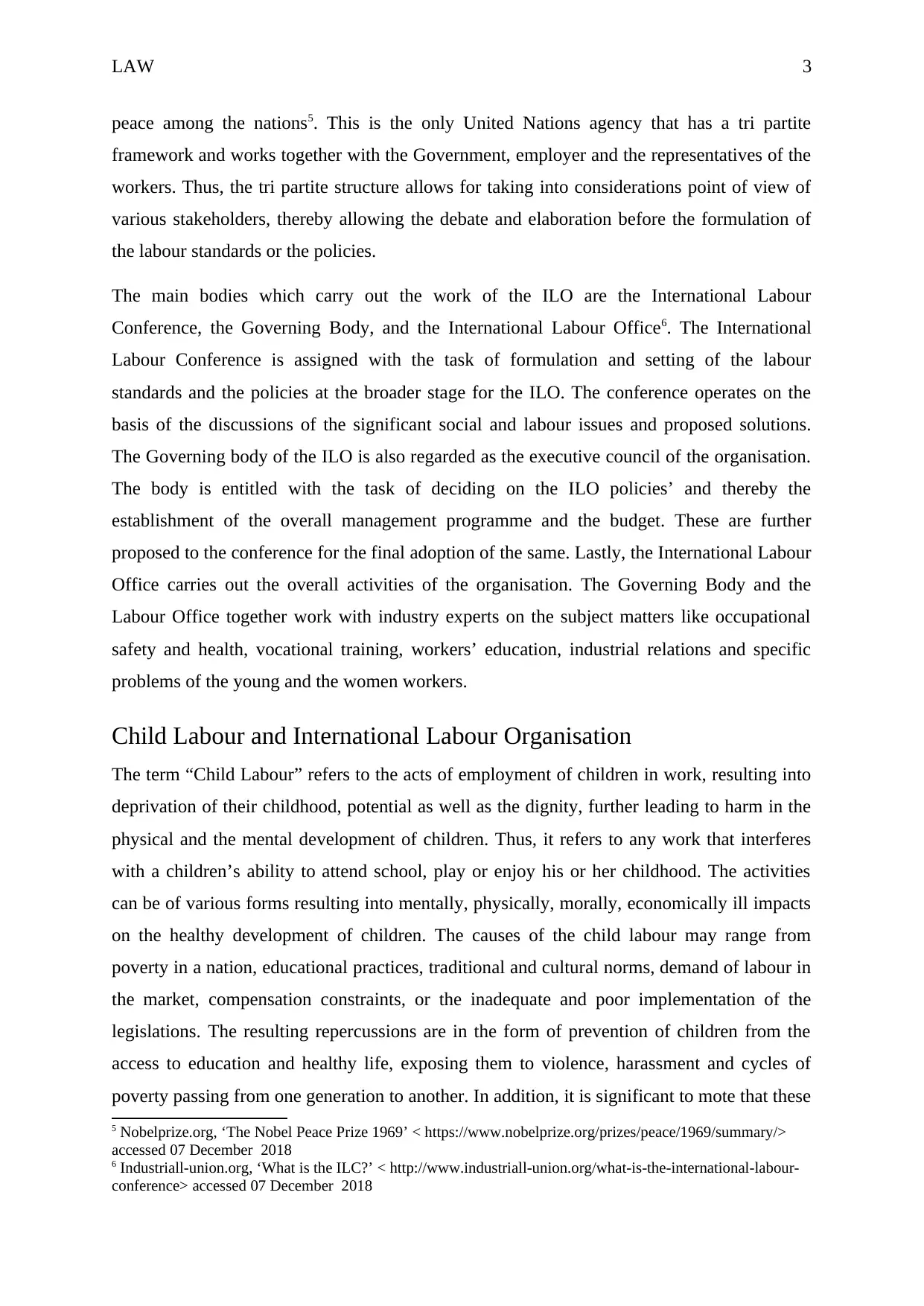
LAW 3
peace among the nations5. This is the only United Nations agency that has a tri partite
framework and works together with the Government, employer and the representatives of the
workers. Thus, the tri partite structure allows for taking into considerations point of view of
various stakeholders, thereby allowing the debate and elaboration before the formulation of
the labour standards or the policies.
The main bodies which carry out the work of the ILO are the International Labour
Conference, the Governing Body, and the International Labour Office6. The International
Labour Conference is assigned with the task of formulation and setting of the labour
standards and the policies at the broader stage for the ILO. The conference operates on the
basis of the discussions of the significant social and labour issues and proposed solutions.
The Governing body of the ILO is also regarded as the executive council of the organisation.
The body is entitled with the task of deciding on the ILO policies’ and thereby the
establishment of the overall management programme and the budget. These are further
proposed to the conference for the final adoption of the same. Lastly, the International Labour
Office carries out the overall activities of the organisation. The Governing Body and the
Labour Office together work with industry experts on the subject matters like occupational
safety and health, vocational training, workers’ education, industrial relations and specific
problems of the young and the women workers.
Child Labour and International Labour Organisation
The term “Child Labour” refers to the acts of employment of children in work, resulting into
deprivation of their childhood, potential as well as the dignity, further leading to harm in the
physical and the mental development of children. Thus, it refers to any work that interferes
with a children’s ability to attend school, play or enjoy his or her childhood. The activities
can be of various forms resulting into mentally, physically, morally, economically ill impacts
on the healthy development of children. The causes of the child labour may range from
poverty in a nation, educational practices, traditional and cultural norms, demand of labour in
the market, compensation constraints, or the inadequate and poor implementation of the
legislations. The resulting repercussions are in the form of prevention of children from the
access to education and healthy life, exposing them to violence, harassment and cycles of
poverty passing from one generation to another. In addition, it is significant to mote that these
5 Nobelprize.org, ‘The Nobel Peace Prize 1969’ < https://www.nobelprize.org/prizes/peace/1969/summary/>
accessed 07 December 2018
6 Industriall-union.org, ‘What is the ILC?’ < http://www.industriall-union.org/what-is-the-international-labour-
conference> accessed 07 December 2018
peace among the nations5. This is the only United Nations agency that has a tri partite
framework and works together with the Government, employer and the representatives of the
workers. Thus, the tri partite structure allows for taking into considerations point of view of
various stakeholders, thereby allowing the debate and elaboration before the formulation of
the labour standards or the policies.
The main bodies which carry out the work of the ILO are the International Labour
Conference, the Governing Body, and the International Labour Office6. The International
Labour Conference is assigned with the task of formulation and setting of the labour
standards and the policies at the broader stage for the ILO. The conference operates on the
basis of the discussions of the significant social and labour issues and proposed solutions.
The Governing body of the ILO is also regarded as the executive council of the organisation.
The body is entitled with the task of deciding on the ILO policies’ and thereby the
establishment of the overall management programme and the budget. These are further
proposed to the conference for the final adoption of the same. Lastly, the International Labour
Office carries out the overall activities of the organisation. The Governing Body and the
Labour Office together work with industry experts on the subject matters like occupational
safety and health, vocational training, workers’ education, industrial relations and specific
problems of the young and the women workers.
Child Labour and International Labour Organisation
The term “Child Labour” refers to the acts of employment of children in work, resulting into
deprivation of their childhood, potential as well as the dignity, further leading to harm in the
physical and the mental development of children. Thus, it refers to any work that interferes
with a children’s ability to attend school, play or enjoy his or her childhood. The activities
can be of various forms resulting into mentally, physically, morally, economically ill impacts
on the healthy development of children. The causes of the child labour may range from
poverty in a nation, educational practices, traditional and cultural norms, demand of labour in
the market, compensation constraints, or the inadequate and poor implementation of the
legislations. The resulting repercussions are in the form of prevention of children from the
access to education and healthy life, exposing them to violence, harassment and cycles of
poverty passing from one generation to another. In addition, it is significant to mote that these
5 Nobelprize.org, ‘The Nobel Peace Prize 1969’ < https://www.nobelprize.org/prizes/peace/1969/summary/>
accessed 07 December 2018
6 Industriall-union.org, ‘What is the ILC?’ < http://www.industriall-union.org/what-is-the-international-labour-
conference> accessed 07 December 2018
Paraphrase This Document
Need a fresh take? Get an instant paraphrase of this document with our AI Paraphraser
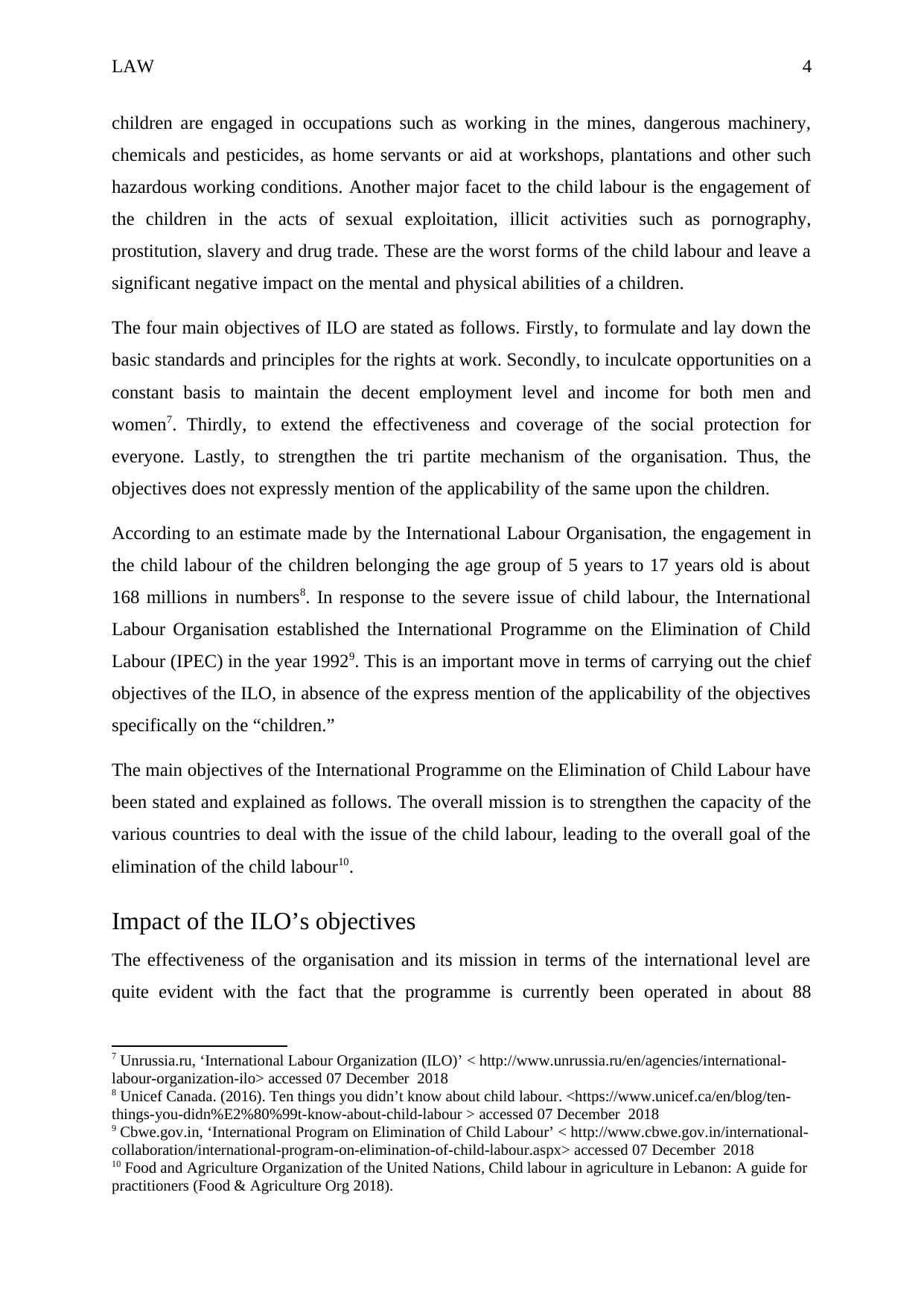
LAW 4
children are engaged in occupations such as working in the mines, dangerous machinery,
chemicals and pesticides, as home servants or aid at workshops, plantations and other such
hazardous working conditions. Another major facet to the child labour is the engagement of
the children in the acts of sexual exploitation, illicit activities such as pornography,
prostitution, slavery and drug trade. These are the worst forms of the child labour and leave a
significant negative impact on the mental and physical abilities of a children.
The four main objectives of ILO are stated as follows. Firstly, to formulate and lay down the
basic standards and principles for the rights at work. Secondly, to inculcate opportunities on a
constant basis to maintain the decent employment level and income for both men and
women7. Thirdly, to extend the effectiveness and coverage of the social protection for
everyone. Lastly, to strengthen the tri partite mechanism of the organisation. Thus, the
objectives does not expressly mention of the applicability of the same upon the children.
According to an estimate made by the International Labour Organisation, the engagement in
the child labour of the children belonging the age group of 5 years to 17 years old is about
168 millions in numbers8. In response to the severe issue of child labour, the International
Labour Organisation established the International Programme on the Elimination of Child
Labour (IPEC) in the year 19929. This is an important move in terms of carrying out the chief
objectives of the ILO, in absence of the express mention of the applicability of the objectives
specifically on the “children.”
The main objectives of the International Programme on the Elimination of Child Labour have
been stated and explained as follows. The overall mission is to strengthen the capacity of the
various countries to deal with the issue of the child labour, leading to the overall goal of the
elimination of the child labour10.
Impact of the ILO’s objectives
The effectiveness of the organisation and its mission in terms of the international level are
quite evident with the fact that the programme is currently been operated in about 88
7 Unrussia.ru, ‘International Labour Organization (ILO)’ < http://www.unrussia.ru/en/agencies/international-
labour-organization-ilo> accessed 07 December 2018
8 Unicef Canada. (2016). Ten things you didn’t know about child labour. <https://www.unicef.ca/en/blog/ten-
things-you-didn%E2%80%99t-know-about-child-labour > accessed 07 December 2018
9 Cbwe.gov.in, ‘International Program on Elimination of Child Labour’ < http://www.cbwe.gov.in/international-
collaboration/international-program-on-elimination-of-child-labour.aspx> accessed 07 December 2018
10 Food and Agriculture Organization of the United Nations, Child labour in agriculture in Lebanon: A guide for
practitioners (Food & Agriculture Org 2018).
children are engaged in occupations such as working in the mines, dangerous machinery,
chemicals and pesticides, as home servants or aid at workshops, plantations and other such
hazardous working conditions. Another major facet to the child labour is the engagement of
the children in the acts of sexual exploitation, illicit activities such as pornography,
prostitution, slavery and drug trade. These are the worst forms of the child labour and leave a
significant negative impact on the mental and physical abilities of a children.
The four main objectives of ILO are stated as follows. Firstly, to formulate and lay down the
basic standards and principles for the rights at work. Secondly, to inculcate opportunities on a
constant basis to maintain the decent employment level and income for both men and
women7. Thirdly, to extend the effectiveness and coverage of the social protection for
everyone. Lastly, to strengthen the tri partite mechanism of the organisation. Thus, the
objectives does not expressly mention of the applicability of the same upon the children.
According to an estimate made by the International Labour Organisation, the engagement in
the child labour of the children belonging the age group of 5 years to 17 years old is about
168 millions in numbers8. In response to the severe issue of child labour, the International
Labour Organisation established the International Programme on the Elimination of Child
Labour (IPEC) in the year 19929. This is an important move in terms of carrying out the chief
objectives of the ILO, in absence of the express mention of the applicability of the objectives
specifically on the “children.”
The main objectives of the International Programme on the Elimination of Child Labour have
been stated and explained as follows. The overall mission is to strengthen the capacity of the
various countries to deal with the issue of the child labour, leading to the overall goal of the
elimination of the child labour10.
Impact of the ILO’s objectives
The effectiveness of the organisation and its mission in terms of the international level are
quite evident with the fact that the programme is currently been operated in about 88
7 Unrussia.ru, ‘International Labour Organization (ILO)’ < http://www.unrussia.ru/en/agencies/international-
labour-organization-ilo> accessed 07 December 2018
8 Unicef Canada. (2016). Ten things you didn’t know about child labour. <https://www.unicef.ca/en/blog/ten-
things-you-didn%E2%80%99t-know-about-child-labour > accessed 07 December 2018
9 Cbwe.gov.in, ‘International Program on Elimination of Child Labour’ < http://www.cbwe.gov.in/international-
collaboration/international-program-on-elimination-of-child-labour.aspx> accessed 07 December 2018
10 Food and Agriculture Organization of the United Nations, Child labour in agriculture in Lebanon: A guide for
practitioners (Food & Agriculture Org 2018).
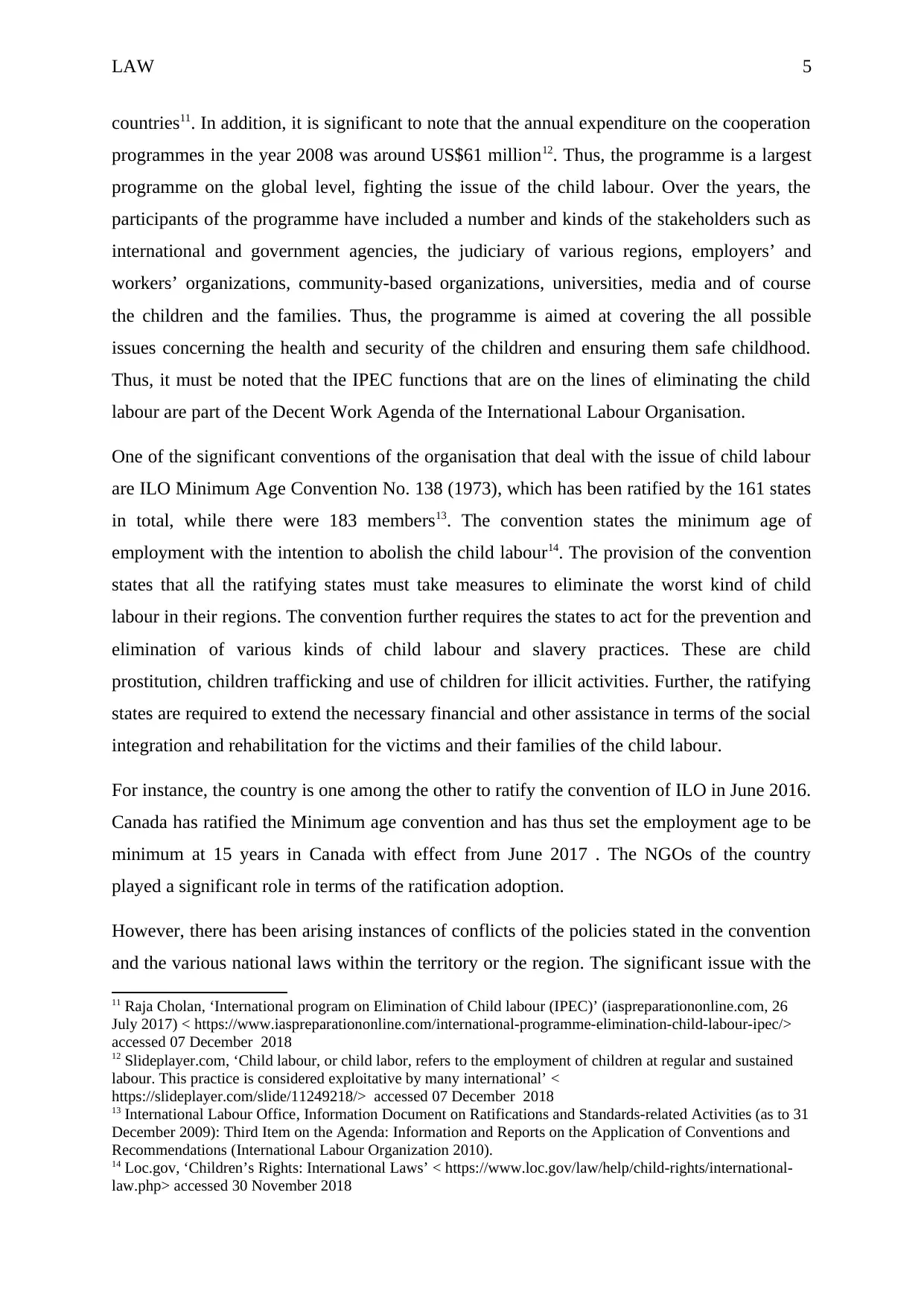
LAW 5
countries11. In addition, it is significant to note that the annual expenditure on the cooperation
programmes in the year 2008 was around US$61 million12. Thus, the programme is a largest
programme on the global level, fighting the issue of the child labour. Over the years, the
participants of the programme have included a number and kinds of the stakeholders such as
international and government agencies, the judiciary of various regions, employers’ and
workers’ organizations, community-based organizations, universities, media and of course
the children and the families. Thus, the programme is aimed at covering the all possible
issues concerning the health and security of the children and ensuring them safe childhood.
Thus, it must be noted that the IPEC functions that are on the lines of eliminating the child
labour are part of the Decent Work Agenda of the International Labour Organisation.
One of the significant conventions of the organisation that deal with the issue of child labour
are ILO Minimum Age Convention No. 138 (1973), which has been ratified by the 161 states
in total, while there were 183 members13. The convention states the minimum age of
employment with the intention to abolish the child labour14. The provision of the convention
states that all the ratifying states must take measures to eliminate the worst kind of child
labour in their regions. The convention further requires the states to act for the prevention and
elimination of various kinds of child labour and slavery practices. These are child
prostitution, children trafficking and use of children for illicit activities. Further, the ratifying
states are required to extend the necessary financial and other assistance in terms of the social
integration and rehabilitation for the victims and their families of the child labour.
For instance, the country is one among the other to ratify the convention of ILO in June 2016.
Canada has ratified the Minimum age convention and has thus set the employment age to be
minimum at 15 years in Canada with effect from June 2017 . The NGOs of the country
played a significant role in terms of the ratification adoption.
However, there has been arising instances of conflicts of the policies stated in the convention
and the various national laws within the territory or the region. The significant issue with the
11 Raja Cholan, ‘International program on Elimination of Child labour (IPEC)’ (iaspreparationonline.com, 26
July 2017) < https://www.iaspreparationonline.com/international-programme-elimination-child-labour-ipec/>
accessed 07 December 2018
12 Slideplayer.com, ‘Child labour, or child labor, refers to the employment of children at regular and sustained
labour. This practice is considered exploitative by many international’ <
https://slideplayer.com/slide/11249218/> accessed 07 December 2018
13 International Labour Office, Information Document on Ratifications and Standards-related Activities (as to 31
December 2009): Third Item on the Agenda: Information and Reports on the Application of Conventions and
Recommendations (International Labour Organization 2010).
14 Loc.gov, ‘Children’s Rights: International Laws’ < https://www.loc.gov/law/help/child-rights/international-
law.php> accessed 30 November 2018
countries11. In addition, it is significant to note that the annual expenditure on the cooperation
programmes in the year 2008 was around US$61 million12. Thus, the programme is a largest
programme on the global level, fighting the issue of the child labour. Over the years, the
participants of the programme have included a number and kinds of the stakeholders such as
international and government agencies, the judiciary of various regions, employers’ and
workers’ organizations, community-based organizations, universities, media and of course
the children and the families. Thus, the programme is aimed at covering the all possible
issues concerning the health and security of the children and ensuring them safe childhood.
Thus, it must be noted that the IPEC functions that are on the lines of eliminating the child
labour are part of the Decent Work Agenda of the International Labour Organisation.
One of the significant conventions of the organisation that deal with the issue of child labour
are ILO Minimum Age Convention No. 138 (1973), which has been ratified by the 161 states
in total, while there were 183 members13. The convention states the minimum age of
employment with the intention to abolish the child labour14. The provision of the convention
states that all the ratifying states must take measures to eliminate the worst kind of child
labour in their regions. The convention further requires the states to act for the prevention and
elimination of various kinds of child labour and slavery practices. These are child
prostitution, children trafficking and use of children for illicit activities. Further, the ratifying
states are required to extend the necessary financial and other assistance in terms of the social
integration and rehabilitation for the victims and their families of the child labour.
For instance, the country is one among the other to ratify the convention of ILO in June 2016.
Canada has ratified the Minimum age convention and has thus set the employment age to be
minimum at 15 years in Canada with effect from June 2017 . The NGOs of the country
played a significant role in terms of the ratification adoption.
However, there has been arising instances of conflicts of the policies stated in the convention
and the various national laws within the territory or the region. The significant issue with the
11 Raja Cholan, ‘International program on Elimination of Child labour (IPEC)’ (iaspreparationonline.com, 26
July 2017) < https://www.iaspreparationonline.com/international-programme-elimination-child-labour-ipec/>
accessed 07 December 2018
12 Slideplayer.com, ‘Child labour, or child labor, refers to the employment of children at regular and sustained
labour. This practice is considered exploitative by many international’ <
https://slideplayer.com/slide/11249218/> accessed 07 December 2018
13 International Labour Office, Information Document on Ratifications and Standards-related Activities (as to 31
December 2009): Third Item on the Agenda: Information and Reports on the Application of Conventions and
Recommendations (International Labour Organization 2010).
14 Loc.gov, ‘Children’s Rights: International Laws’ < https://www.loc.gov/law/help/child-rights/international-
law.php> accessed 30 November 2018
⊘ This is a preview!⊘
Do you want full access?
Subscribe today to unlock all pages.

Trusted by 1+ million students worldwide
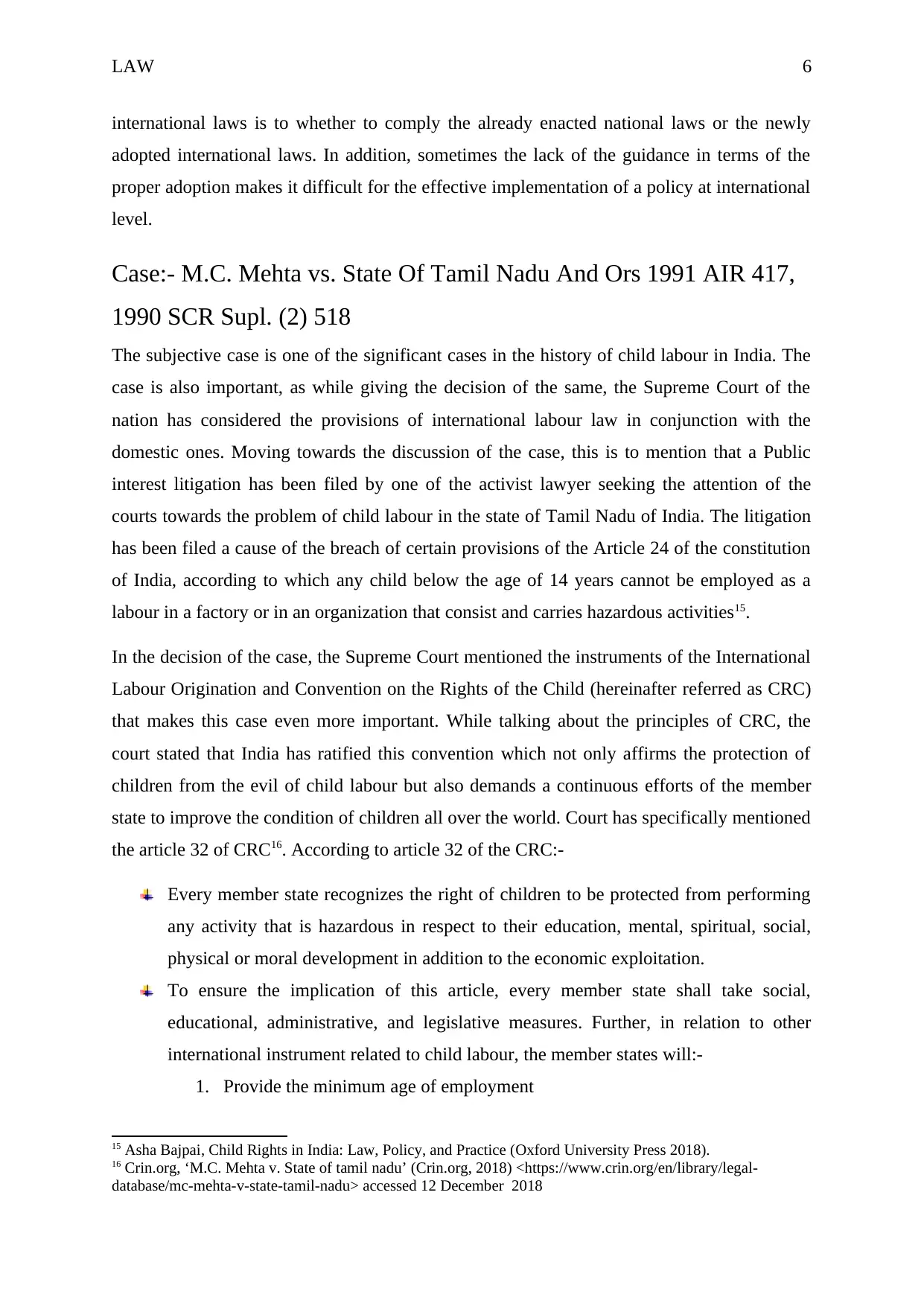
LAW 6
international laws is to whether to comply the already enacted national laws or the newly
adopted international laws. In addition, sometimes the lack of the guidance in terms of the
proper adoption makes it difficult for the effective implementation of a policy at international
level.
Case:- M.C. Mehta vs. State Of Tamil Nadu And Ors 1991 AIR 417,
1990 SCR Supl. (2) 518
The subjective case is one of the significant cases in the history of child labour in India. The
case is also important, as while giving the decision of the same, the Supreme Court of the
nation has considered the provisions of international labour law in conjunction with the
domestic ones. Moving towards the discussion of the case, this is to mention that a Public
interest litigation has been filed by one of the activist lawyer seeking the attention of the
courts towards the problem of child labour in the state of Tamil Nadu of India. The litigation
has been filed a cause of the breach of certain provisions of the Article 24 of the constitution
of India, according to which any child below the age of 14 years cannot be employed as a
labour in a factory or in an organization that consist and carries hazardous activities15.
In the decision of the case, the Supreme Court mentioned the instruments of the International
Labour Origination and Convention on the Rights of the Child (hereinafter referred as CRC)
that makes this case even more important. While talking about the principles of CRC, the
court stated that India has ratified this convention which not only affirms the protection of
children from the evil of child labour but also demands a continuous efforts of the member
state to improve the condition of children all over the world. Court has specifically mentioned
the article 32 of CRC16. According to article 32 of the CRC:-
Every member state recognizes the right of children to be protected from performing
any activity that is hazardous in respect to their education, mental, spiritual, social,
physical or moral development in addition to the economic exploitation.
To ensure the implication of this article, every member state shall take social,
educational, administrative, and legislative measures. Further, in relation to other
international instrument related to child labour, the member states will:-
1. Provide the minimum age of employment
15 Asha Bajpai, Child Rights in India: Law, Policy, and Practice (Oxford University Press 2018).
16 Crin.org, ‘M.C. Mehta v. State of tamil nadu’ (Crin.org, 2018) <https://www.crin.org/en/library/legal-
database/mc-mehta-v-state-tamil-nadu> accessed 12 December 2018
international laws is to whether to comply the already enacted national laws or the newly
adopted international laws. In addition, sometimes the lack of the guidance in terms of the
proper adoption makes it difficult for the effective implementation of a policy at international
level.
Case:- M.C. Mehta vs. State Of Tamil Nadu And Ors 1991 AIR 417,
1990 SCR Supl. (2) 518
The subjective case is one of the significant cases in the history of child labour in India. The
case is also important, as while giving the decision of the same, the Supreme Court of the
nation has considered the provisions of international labour law in conjunction with the
domestic ones. Moving towards the discussion of the case, this is to mention that a Public
interest litigation has been filed by one of the activist lawyer seeking the attention of the
courts towards the problem of child labour in the state of Tamil Nadu of India. The litigation
has been filed a cause of the breach of certain provisions of the Article 24 of the constitution
of India, according to which any child below the age of 14 years cannot be employed as a
labour in a factory or in an organization that consist and carries hazardous activities15.
In the decision of the case, the Supreme Court mentioned the instruments of the International
Labour Origination and Convention on the Rights of the Child (hereinafter referred as CRC)
that makes this case even more important. While talking about the principles of CRC, the
court stated that India has ratified this convention which not only affirms the protection of
children from the evil of child labour but also demands a continuous efforts of the member
state to improve the condition of children all over the world. Court has specifically mentioned
the article 32 of CRC16. According to article 32 of the CRC:-
Every member state recognizes the right of children to be protected from performing
any activity that is hazardous in respect to their education, mental, spiritual, social,
physical or moral development in addition to the economic exploitation.
To ensure the implication of this article, every member state shall take social,
educational, administrative, and legislative measures. Further, in relation to other
international instrument related to child labour, the member states will:-
1. Provide the minimum age of employment
15 Asha Bajpai, Child Rights in India: Law, Policy, and Practice (Oxford University Press 2018).
16 Crin.org, ‘M.C. Mehta v. State of tamil nadu’ (Crin.org, 2018) <https://www.crin.org/en/library/legal-
database/mc-mehta-v-state-tamil-nadu> accessed 12 December 2018
Paraphrase This Document
Need a fresh take? Get an instant paraphrase of this document with our AI Paraphraser
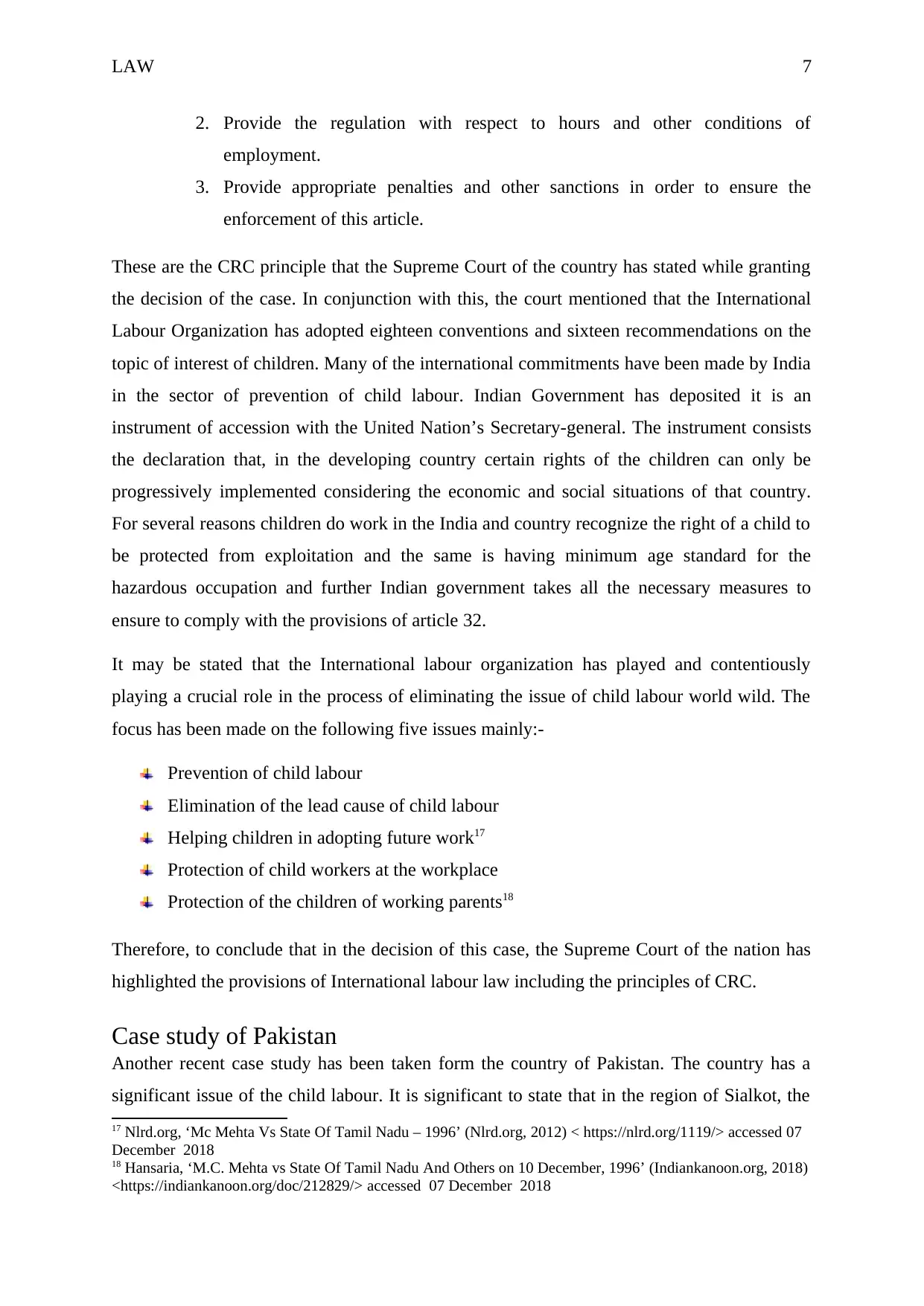
LAW 7
2. Provide the regulation with respect to hours and other conditions of
employment.
3. Provide appropriate penalties and other sanctions in order to ensure the
enforcement of this article.
These are the CRC principle that the Supreme Court of the country has stated while granting
the decision of the case. In conjunction with this, the court mentioned that the International
Labour Organization has adopted eighteen conventions and sixteen recommendations on the
topic of interest of children. Many of the international commitments have been made by India
in the sector of prevention of child labour. Indian Government has deposited it is an
instrument of accession with the United Nation’s Secretary-general. The instrument consists
the declaration that, in the developing country certain rights of the children can only be
progressively implemented considering the economic and social situations of that country.
For several reasons children do work in the India and country recognize the right of a child to
be protected from exploitation and the same is having minimum age standard for the
hazardous occupation and further Indian government takes all the necessary measures to
ensure to comply with the provisions of article 32.
It may be stated that the International labour organization has played and contentiously
playing a crucial role in the process of eliminating the issue of child labour world wild. The
focus has been made on the following five issues mainly:-
Prevention of child labour
Elimination of the lead cause of child labour
Helping children in adopting future work17
Protection of child workers at the workplace
Protection of the children of working parents18
Therefore, to conclude that in the decision of this case, the Supreme Court of the nation has
highlighted the provisions of International labour law including the principles of CRC.
Case study of Pakistan
Another recent case study has been taken form the country of Pakistan. The country has a
significant issue of the child labour. It is significant to state that in the region of Sialkot, the
17 Nlrd.org, ‘Mc Mehta Vs State Of Tamil Nadu – 1996’ (Nlrd.org, 2012) < https://nlrd.org/1119/> accessed 07
December 2018
18 Hansaria, ‘M.C. Mehta vs State Of Tamil Nadu And Others on 10 December, 1996’ (Indiankanoon.org, 2018)
<https://indiankanoon.org/doc/212829/> accessed 07 December 2018
2. Provide the regulation with respect to hours and other conditions of
employment.
3. Provide appropriate penalties and other sanctions in order to ensure the
enforcement of this article.
These are the CRC principle that the Supreme Court of the country has stated while granting
the decision of the case. In conjunction with this, the court mentioned that the International
Labour Organization has adopted eighteen conventions and sixteen recommendations on the
topic of interest of children. Many of the international commitments have been made by India
in the sector of prevention of child labour. Indian Government has deposited it is an
instrument of accession with the United Nation’s Secretary-general. The instrument consists
the declaration that, in the developing country certain rights of the children can only be
progressively implemented considering the economic and social situations of that country.
For several reasons children do work in the India and country recognize the right of a child to
be protected from exploitation and the same is having minimum age standard for the
hazardous occupation and further Indian government takes all the necessary measures to
ensure to comply with the provisions of article 32.
It may be stated that the International labour organization has played and contentiously
playing a crucial role in the process of eliminating the issue of child labour world wild. The
focus has been made on the following five issues mainly:-
Prevention of child labour
Elimination of the lead cause of child labour
Helping children in adopting future work17
Protection of child workers at the workplace
Protection of the children of working parents18
Therefore, to conclude that in the decision of this case, the Supreme Court of the nation has
highlighted the provisions of International labour law including the principles of CRC.
Case study of Pakistan
Another recent case study has been taken form the country of Pakistan. The country has a
significant issue of the child labour. It is significant to state that in the region of Sialkot, the
17 Nlrd.org, ‘Mc Mehta Vs State Of Tamil Nadu – 1996’ (Nlrd.org, 2012) < https://nlrd.org/1119/> accessed 07
December 2018
18 Hansaria, ‘M.C. Mehta vs State Of Tamil Nadu And Others on 10 December, 1996’ (Indiankanoon.org, 2018)
<https://indiankanoon.org/doc/212829/> accessed 07 December 2018
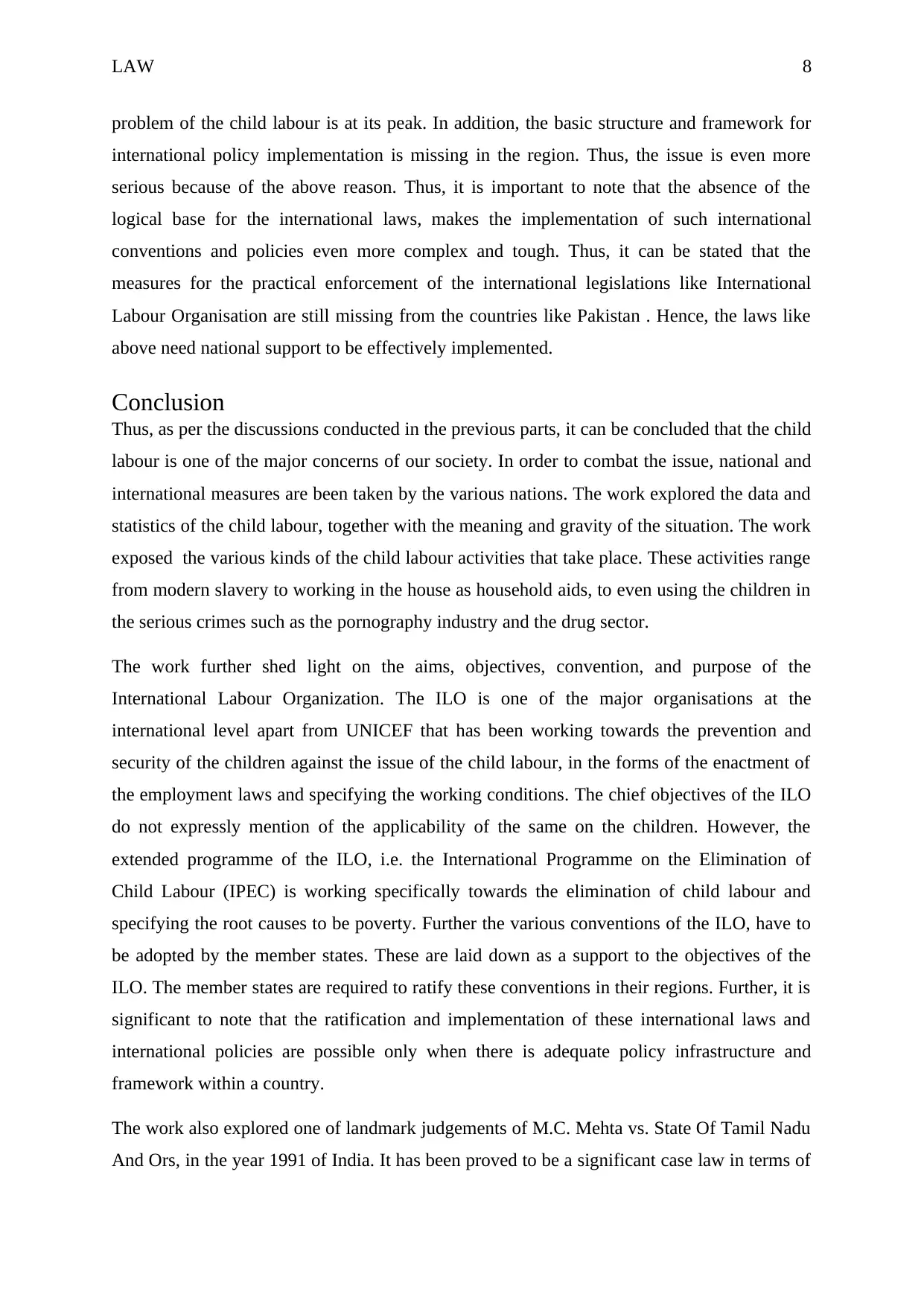
LAW 8
problem of the child labour is at its peak. In addition, the basic structure and framework for
international policy implementation is missing in the region. Thus, the issue is even more
serious because of the above reason. Thus, it is important to note that the absence of the
logical base for the international laws, makes the implementation of such international
conventions and policies even more complex and tough. Thus, it can be stated that the
measures for the practical enforcement of the international legislations like International
Labour Organisation are still missing from the countries like Pakistan . Hence, the laws like
above need national support to be effectively implemented.
Conclusion
Thus, as per the discussions conducted in the previous parts, it can be concluded that the child
labour is one of the major concerns of our society. In order to combat the issue, national and
international measures are been taken by the various nations. The work explored the data and
statistics of the child labour, together with the meaning and gravity of the situation. The work
exposed the various kinds of the child labour activities that take place. These activities range
from modern slavery to working in the house as household aids, to even using the children in
the serious crimes such as the pornography industry and the drug sector.
The work further shed light on the aims, objectives, convention, and purpose of the
International Labour Organization. The ILO is one of the major organisations at the
international level apart from UNICEF that has been working towards the prevention and
security of the children against the issue of the child labour, in the forms of the enactment of
the employment laws and specifying the working conditions. The chief objectives of the ILO
do not expressly mention of the applicability of the same on the children. However, the
extended programme of the ILO, i.e. the International Programme on the Elimination of
Child Labour (IPEC) is working specifically towards the elimination of child labour and
specifying the root causes to be poverty. Further the various conventions of the ILO, have to
be adopted by the member states. These are laid down as a support to the objectives of the
ILO. The member states are required to ratify these conventions in their regions. Further, it is
significant to note that the ratification and implementation of these international laws and
international policies are possible only when there is adequate policy infrastructure and
framework within a country.
The work also explored one of landmark judgements of M.C. Mehta vs. State Of Tamil Nadu
And Ors, in the year 1991 of India. It has been proved to be a significant case law in terms of
problem of the child labour is at its peak. In addition, the basic structure and framework for
international policy implementation is missing in the region. Thus, the issue is even more
serious because of the above reason. Thus, it is important to note that the absence of the
logical base for the international laws, makes the implementation of such international
conventions and policies even more complex and tough. Thus, it can be stated that the
measures for the practical enforcement of the international legislations like International
Labour Organisation are still missing from the countries like Pakistan . Hence, the laws like
above need national support to be effectively implemented.
Conclusion
Thus, as per the discussions conducted in the previous parts, it can be concluded that the child
labour is one of the major concerns of our society. In order to combat the issue, national and
international measures are been taken by the various nations. The work explored the data and
statistics of the child labour, together with the meaning and gravity of the situation. The work
exposed the various kinds of the child labour activities that take place. These activities range
from modern slavery to working in the house as household aids, to even using the children in
the serious crimes such as the pornography industry and the drug sector.
The work further shed light on the aims, objectives, convention, and purpose of the
International Labour Organization. The ILO is one of the major organisations at the
international level apart from UNICEF that has been working towards the prevention and
security of the children against the issue of the child labour, in the forms of the enactment of
the employment laws and specifying the working conditions. The chief objectives of the ILO
do not expressly mention of the applicability of the same on the children. However, the
extended programme of the ILO, i.e. the International Programme on the Elimination of
Child Labour (IPEC) is working specifically towards the elimination of child labour and
specifying the root causes to be poverty. Further the various conventions of the ILO, have to
be adopted by the member states. These are laid down as a support to the objectives of the
ILO. The member states are required to ratify these conventions in their regions. Further, it is
significant to note that the ratification and implementation of these international laws and
international policies are possible only when there is adequate policy infrastructure and
framework within a country.
The work also explored one of landmark judgements of M.C. Mehta vs. State Of Tamil Nadu
And Ors, in the year 1991 of India. It has been proved to be a significant case law in terms of
⊘ This is a preview!⊘
Do you want full access?
Subscribe today to unlock all pages.

Trusted by 1+ million students worldwide
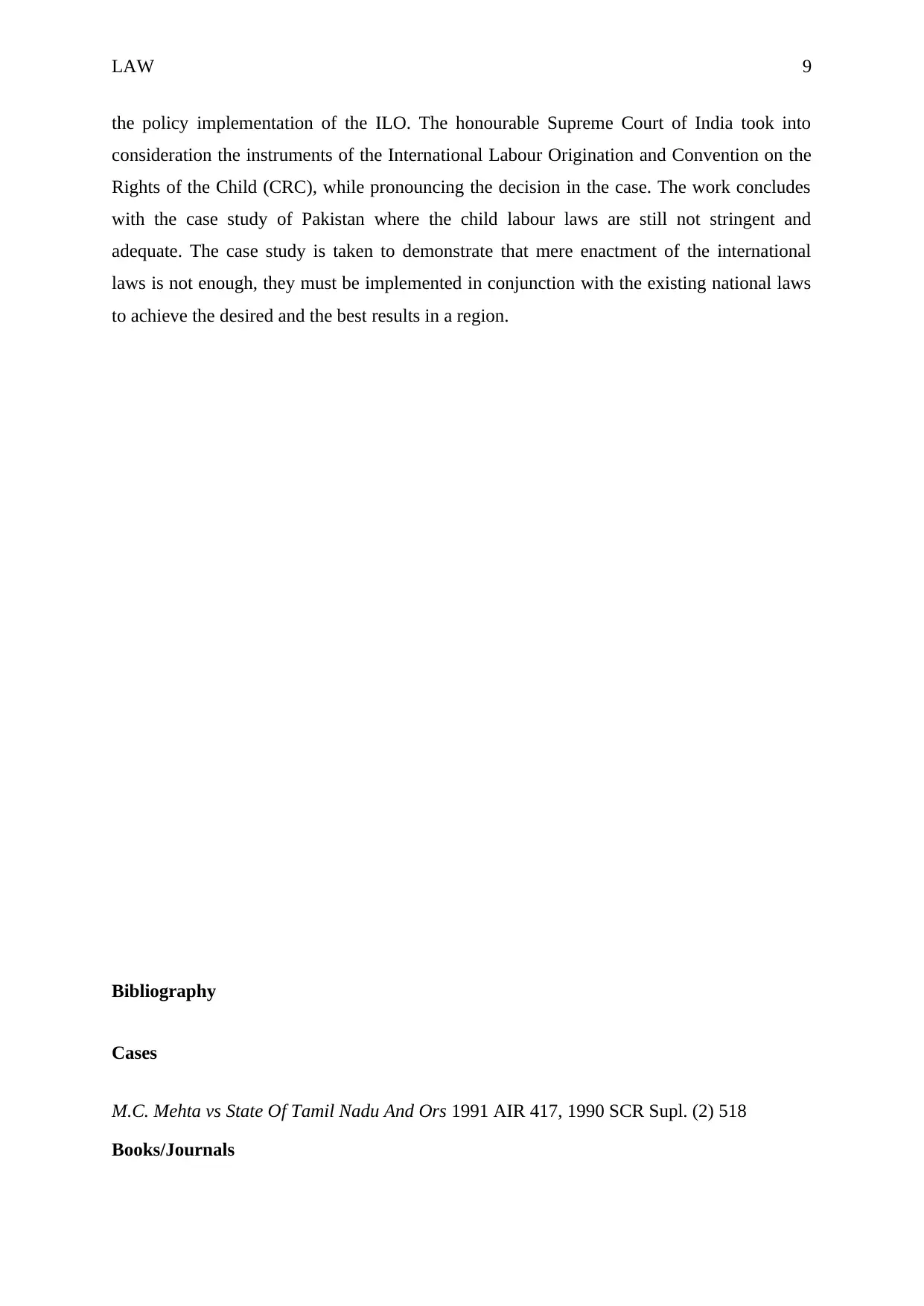
LAW 9
the policy implementation of the ILO. The honourable Supreme Court of India took into
consideration the instruments of the International Labour Origination and Convention on the
Rights of the Child (CRC), while pronouncing the decision in the case. The work concludes
with the case study of Pakistan where the child labour laws are still not stringent and
adequate. The case study is taken to demonstrate that mere enactment of the international
laws is not enough, they must be implemented in conjunction with the existing national laws
to achieve the desired and the best results in a region.
Bibliography
Cases
M.C. Mehta vs State Of Tamil Nadu And Ors 1991 AIR 417, 1990 SCR Supl. (2) 518
Books/Journals
the policy implementation of the ILO. The honourable Supreme Court of India took into
consideration the instruments of the International Labour Origination and Convention on the
Rights of the Child (CRC), while pronouncing the decision in the case. The work concludes
with the case study of Pakistan where the child labour laws are still not stringent and
adequate. The case study is taken to demonstrate that mere enactment of the international
laws is not enough, they must be implemented in conjunction with the existing national laws
to achieve the desired and the best results in a region.
Bibliography
Cases
M.C. Mehta vs State Of Tamil Nadu And Ors 1991 AIR 417, 1990 SCR Supl. (2) 518
Books/Journals
Paraphrase This Document
Need a fresh take? Get an instant paraphrase of this document with our AI Paraphraser
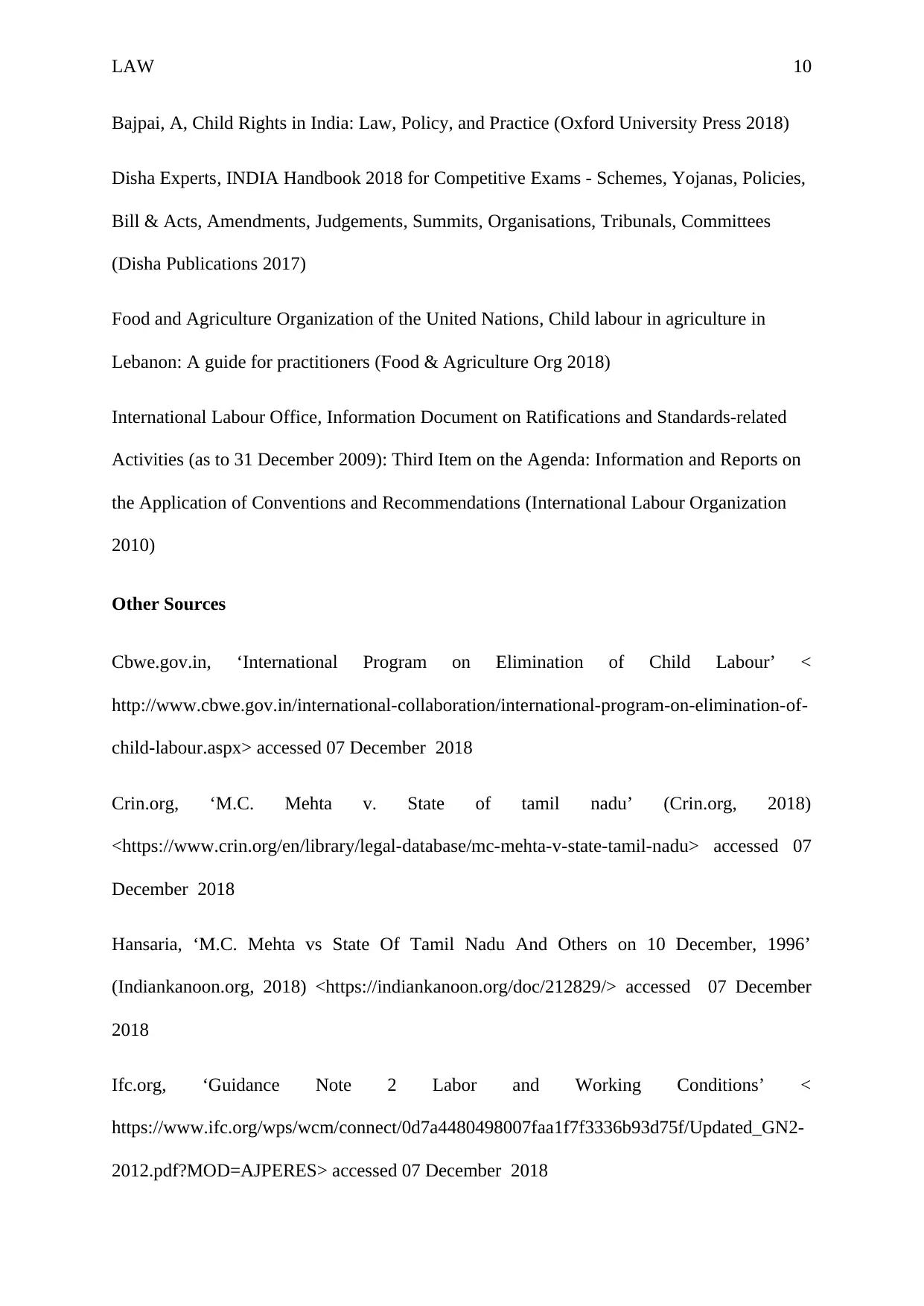
LAW 10
Bajpai, A, Child Rights in India: Law, Policy, and Practice (Oxford University Press 2018)
Disha Experts, INDIA Handbook 2018 for Competitive Exams - Schemes, Yojanas, Policies,
Bill & Acts, Amendments, Judgements, Summits, Organisations, Tribunals, Committees
(Disha Publications 2017)
Food and Agriculture Organization of the United Nations, Child labour in agriculture in
Lebanon: A guide for practitioners (Food & Agriculture Org 2018)
International Labour Office, Information Document on Ratifications and Standards-related
Activities (as to 31 December 2009): Third Item on the Agenda: Information and Reports on
the Application of Conventions and Recommendations (International Labour Organization
2010)
Other Sources
Cbwe.gov.in, ‘International Program on Elimination of Child Labour’ <
http://www.cbwe.gov.in/international-collaboration/international-program-on-elimination-of-
child-labour.aspx> accessed 07 December 2018
Crin.org, ‘M.C. Mehta v. State of tamil nadu’ (Crin.org, 2018)
<https://www.crin.org/en/library/legal-database/mc-mehta-v-state-tamil-nadu> accessed 07
December 2018
Hansaria, ‘M.C. Mehta vs State Of Tamil Nadu And Others on 10 December, 1996’
(Indiankanoon.org, 2018) <https://indiankanoon.org/doc/212829/> accessed 07 December
2018
Ifc.org, ‘Guidance Note 2 Labor and Working Conditions’ <
https://www.ifc.org/wps/wcm/connect/0d7a4480498007faa1f7f3336b93d75f/Updated_GN2-
2012.pdf?MOD=AJPERES> accessed 07 December 2018
Bajpai, A, Child Rights in India: Law, Policy, and Practice (Oxford University Press 2018)
Disha Experts, INDIA Handbook 2018 for Competitive Exams - Schemes, Yojanas, Policies,
Bill & Acts, Amendments, Judgements, Summits, Organisations, Tribunals, Committees
(Disha Publications 2017)
Food and Agriculture Organization of the United Nations, Child labour in agriculture in
Lebanon: A guide for practitioners (Food & Agriculture Org 2018)
International Labour Office, Information Document on Ratifications and Standards-related
Activities (as to 31 December 2009): Third Item on the Agenda: Information and Reports on
the Application of Conventions and Recommendations (International Labour Organization
2010)
Other Sources
Cbwe.gov.in, ‘International Program on Elimination of Child Labour’ <
http://www.cbwe.gov.in/international-collaboration/international-program-on-elimination-of-
child-labour.aspx> accessed 07 December 2018
Crin.org, ‘M.C. Mehta v. State of tamil nadu’ (Crin.org, 2018)
<https://www.crin.org/en/library/legal-database/mc-mehta-v-state-tamil-nadu> accessed 07
December 2018
Hansaria, ‘M.C. Mehta vs State Of Tamil Nadu And Others on 10 December, 1996’
(Indiankanoon.org, 2018) <https://indiankanoon.org/doc/212829/> accessed 07 December
2018
Ifc.org, ‘Guidance Note 2 Labor and Working Conditions’ <
https://www.ifc.org/wps/wcm/connect/0d7a4480498007faa1f7f3336b93d75f/Updated_GN2-
2012.pdf?MOD=AJPERES> accessed 07 December 2018
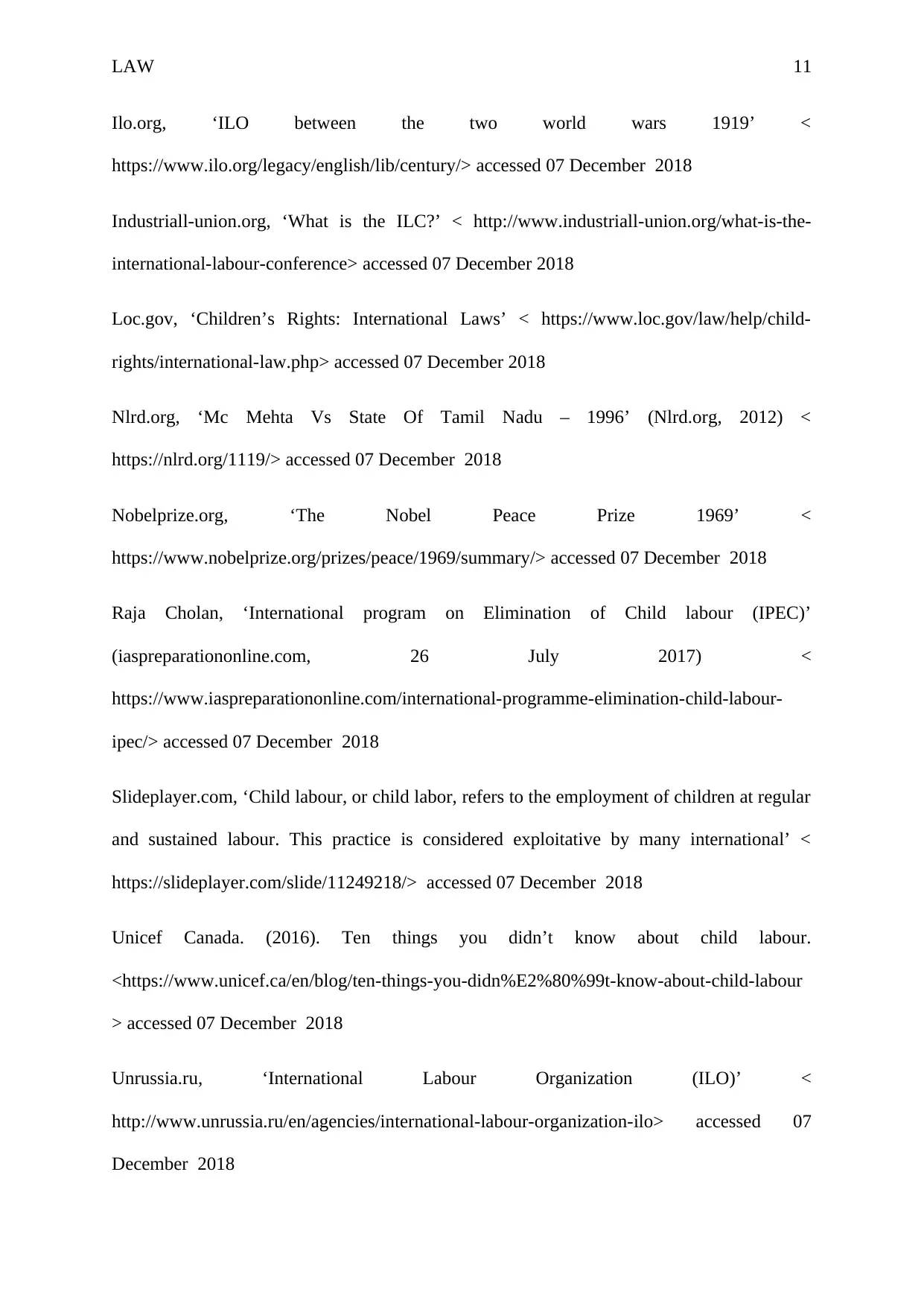
LAW 11
Ilo.org, ‘ILO between the two world wars 1919’ <
https://www.ilo.org/legacy/english/lib/century/> accessed 07 December 2018
Industriall-union.org, ‘What is the ILC?’ < http://www.industriall-union.org/what-is-the-
international-labour-conference> accessed 07 December 2018
Loc.gov, ‘Children’s Rights: International Laws’ < https://www.loc.gov/law/help/child-
rights/international-law.php> accessed 07 December 2018
Nlrd.org, ‘Mc Mehta Vs State Of Tamil Nadu – 1996’ (Nlrd.org, 2012) <
https://nlrd.org/1119/> accessed 07 December 2018
Nobelprize.org, ‘The Nobel Peace Prize 1969’ <
https://www.nobelprize.org/prizes/peace/1969/summary/> accessed 07 December 2018
Raja Cholan, ‘International program on Elimination of Child labour (IPEC)’
(iaspreparationonline.com, 26 July 2017) <
https://www.iaspreparationonline.com/international-programme-elimination-child-labour-
ipec/> accessed 07 December 2018
Slideplayer.com, ‘Child labour, or child labor, refers to the employment of children at regular
and sustained labour. This practice is considered exploitative by many international’ <
https://slideplayer.com/slide/11249218/> accessed 07 December 2018
Unicef Canada. (2016). Ten things you didn’t know about child labour.
<https://www.unicef.ca/en/blog/ten-things-you-didn%E2%80%99t-know-about-child-labour
> accessed 07 December 2018
Unrussia.ru, ‘International Labour Organization (ILO)’ <
http://www.unrussia.ru/en/agencies/international-labour-organization-ilo> accessed 07
December 2018
Ilo.org, ‘ILO between the two world wars 1919’ <
https://www.ilo.org/legacy/english/lib/century/> accessed 07 December 2018
Industriall-union.org, ‘What is the ILC?’ < http://www.industriall-union.org/what-is-the-
international-labour-conference> accessed 07 December 2018
Loc.gov, ‘Children’s Rights: International Laws’ < https://www.loc.gov/law/help/child-
rights/international-law.php> accessed 07 December 2018
Nlrd.org, ‘Mc Mehta Vs State Of Tamil Nadu – 1996’ (Nlrd.org, 2012) <
https://nlrd.org/1119/> accessed 07 December 2018
Nobelprize.org, ‘The Nobel Peace Prize 1969’ <
https://www.nobelprize.org/prizes/peace/1969/summary/> accessed 07 December 2018
Raja Cholan, ‘International program on Elimination of Child labour (IPEC)’
(iaspreparationonline.com, 26 July 2017) <
https://www.iaspreparationonline.com/international-programme-elimination-child-labour-
ipec/> accessed 07 December 2018
Slideplayer.com, ‘Child labour, or child labor, refers to the employment of children at regular
and sustained labour. This practice is considered exploitative by many international’ <
https://slideplayer.com/slide/11249218/> accessed 07 December 2018
Unicef Canada. (2016). Ten things you didn’t know about child labour.
<https://www.unicef.ca/en/blog/ten-things-you-didn%E2%80%99t-know-about-child-labour
> accessed 07 December 2018
Unrussia.ru, ‘International Labour Organization (ILO)’ <
http://www.unrussia.ru/en/agencies/international-labour-organization-ilo> accessed 07
December 2018
⊘ This is a preview!⊘
Do you want full access?
Subscribe today to unlock all pages.

Trusted by 1+ million students worldwide
1 out of 13
Your All-in-One AI-Powered Toolkit for Academic Success.
+13062052269
info@desklib.com
Available 24*7 on WhatsApp / Email
![[object Object]](/_next/static/media/star-bottom.7253800d.svg)
Unlock your academic potential
Copyright © 2020–2025 A2Z Services. All Rights Reserved. Developed and managed by ZUCOL.